I started making no-knead bread in 2010 and it has continued to be my favorite way to make homemade bread because it’s incredibly simple, it doesn’t require a lot of effort, and it makes the most deliciously crusty bakery-style bread ever. To make this no-knead bread recipe you only need four ingredients (including water) and a little bit of time. No fancy equipment or techniques needed!
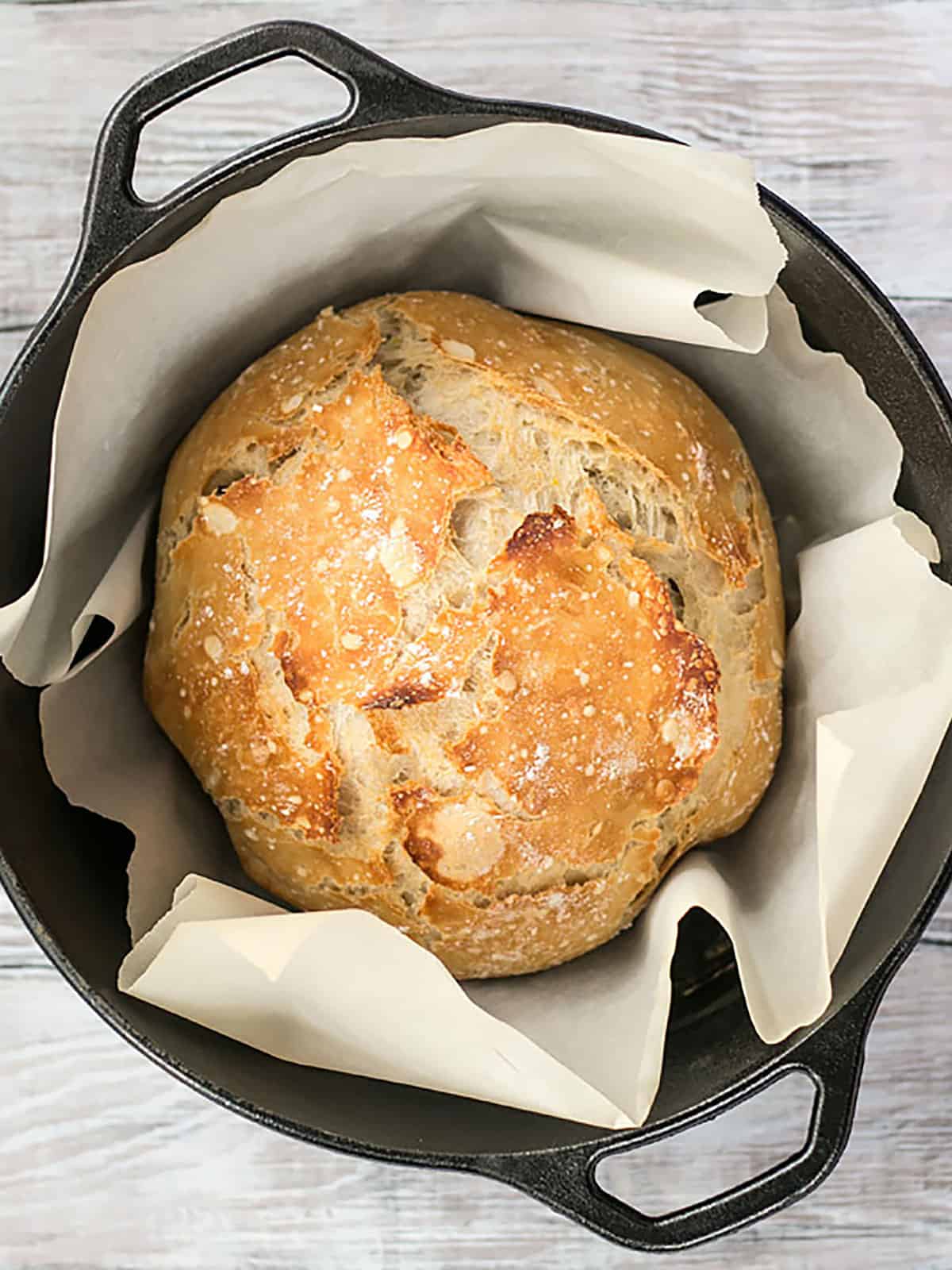
This post contains some affiliate links, which means that we make a small commission off items you purchase at no additional cost to you.
“I’ve made this twice and it was amazing! Hard to believe something so simple can come together to be something so amazing!”
-Melissa
What Is No Knead Bread?
No-knead bread is an ancient technique for making delicious loaves of bread by utilizing a long fermentation time to develop the gluten the flour instead of hand kneading. Gluten is the protein that gives bread its strength, allowing it to rise into a fluffy loaf, and have that deliciously chewy texture. Kneading bread dough develops gluten quickly, but is quite labor-intensive. If given enough time, yeast can develop the gluten in the dough without the need for manual needing.
Ingredients for No Knead Bread
The best part about this no-knead bread recipe is that it only requires four ingredients, including water, and you still get an incredibly flavorful bread. Here’s all you’ll need to make your own homemade no-knead bread:
- Flour: Our version of no-knead bread was developed using all-purpose flour because that is what we most commonly have on hand. That being said, using bread flour will create even better results. Just keep in mind that bread flour tends to absorb more water than all-purpose flour, so you may need to adjust the ratios slightly.
- Yeast: For this type of bread, we use instant yeast or bread machine yeast, both of which do not need to be activated first by proofing in warm water. You can simply add them to your dry ingredients and go!
- Salt: Without the proper amount of salt, homemade bread will have no flavor, so it’s imperative that you do not skip the salt.
- Water: Water hydrates the flour to create the dough. Because this technique uses a longer ferment time, you can use room-temperature water and you do not have to “wake up” the yeast with warm water. The yeast will have plenty of time to activate as it rests.
What Kind of Yeast to Use
It’s very important to use the correct type of yeast for this recipe. Instant yeast and bread machine yeast are special because they do not require mixing with warm water to “wake up” before adding to a recipe. You can simply stir them into the dry ingredients and they will activate instantly upon hydration, so that is what we use for this super simple no-knead bread technique. Active Dry yeast, on the other hand, needs to be specifically activated in warm water first. If you use active dry yeast in this recipe using the technique below, the bread will likely not rise.
Do I Need to Use a Dutch Oven?
Using a preheated Dutch oven does create the best results because it gives the bread an extra intense boost of heat while retaining all of the moisture and steam. That being said, I have made no-knead bread on a sheet pan with great results! I suggest adding a pan with an inch or so of water on the bottom rack of your oven to create steam if you’re baking your bread on a sheet pan.
If possible, I would suggest investing in a Dutch Oven because they are easily one of the most flexible and useful pieces of cookware. We love our Amazon Basics 6-Quart Enameled Dutch Oven as a very affordable alternative to Le Creuset. Lodge also makes very affordable Enameled Dutch Ovens and plain Cast Iron Dutch Ovens (like the one used in the photos here).
Short Fermentation vs. Long Fermentation
You can make no-knead bread using either a long fermentation (12-18 hours) or a short fermentation (about 2 hours). The difference is that you’ll need more yeast to do the short fermentation and the flavor does not develop quite as deeply. That being said, short fermentation no-knead bread is a great option when you haven’t planned ahead!
Long Fermenation: Follow the instructions below, using ¼ tsp yeast and fermenting the dough for 12-18 hours.
Short Fermentation: Use 2 tsp yeast (or one ¼ oz. packet) and ferment the dough for about 2 hours at room temperature.
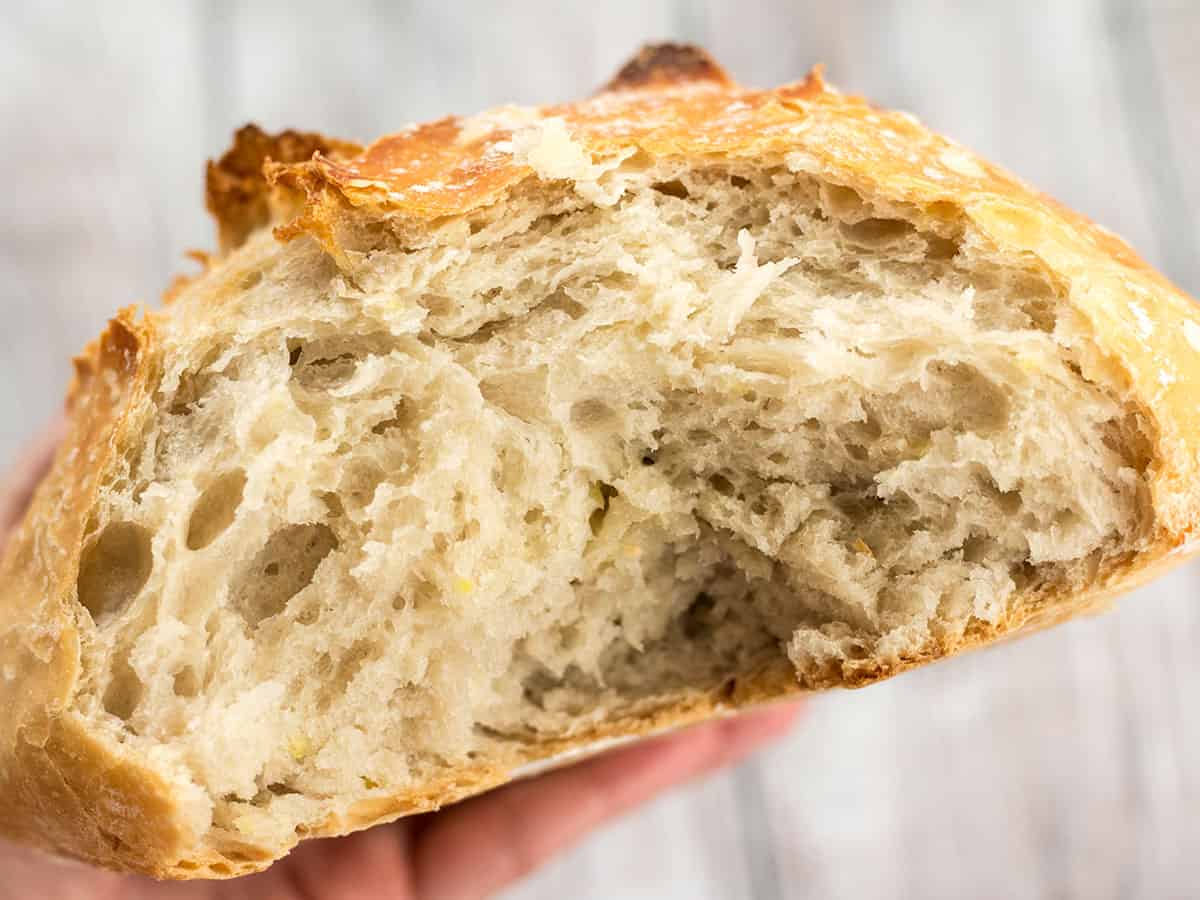
No-Knead Bread
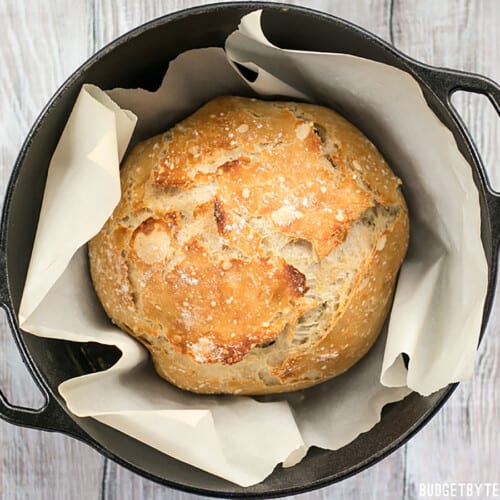
Ingredients
- 3 cups all-purpose flour ($0.29)
- 1/4 tsp instant yeast or bread machine yeast* ($0.02)
- 1.5 tsp salt ($0.02)
- 1.5 to 1.75 cup water** ($0.00)
Instructions
- The day before baking, combine the flour, yeast, and salt in a large bowl and stir until they're well combined. Stir in about 1.5 to 1.75 cups room temperature water until a shaggy, sticky ball of dough forms and there is no dry flour left on the bottom of the bowl. The dough should be wet and sticky, but not so wet that it appears glossy. Cover the bowl loosely with plastic and let it sit at room temperature for 12-18 hours.
- The next day, the dough should be fluffy and very bubbly. When you're ready to bake, sprinkle a little flour on top of the fermented dough and scrape it out of the bowl. With well-floured hands, shape the dough into a ball and place it on a piece of parchment paper. Let the dough rise for 30-60 minutes.
- While the dough is rising, preheat the oven to 425ºF, or the highest recommended temperature listed on the packaging for your parchment paper. Place the Dutch oven inside the oven as it preheats, and make sure it sits in the fully heated oven for at least 15 minutes before baking the bread.
- Once the bread has risen and the Dutch oven is fully heated, carefully remove the Dutch oven from the oven (it will be EXTREMELY hot). Lift the parchment with the dough straight into the dutch oven and cover it with the lid.
- Return the Dutch oven to the oven and bake for 30 minutes. Carefully remove the lid and bake for another 15-20 minutes, or until the crust is a deep golden brown. Remove the Dutch oven from the oven, lift the bread out by by using the parchment paper, and allow it to cool before cutting open and serving.
Sheet Pan Instructions
- Ferment and shape the dough as described above, then place it on a parchment-lined sheet pan to rise for an additional 30 minutes.
- Place a baking pan with about an inch of water on the bottom rack of the oven, then preheat to 425ºF while the dough rises.
- Once the loaf has risen for 30 minutes and the oven is fully preheated, carefully score the top of the dough with a sharp knife (use horizontal motions with no downward pressure). Transfer the sheet pan to the oven and bake for 40 minutes, or until the crust is deeply golden brown and the loaf sounds hollow when tapped.
See how we calculate recipe costs here.
Equipment
- Cast Iron Dutch Oven
- Mixing Bowls
- Parchment Paper
- Liquid Measuring Cup
Notes
Nutrition
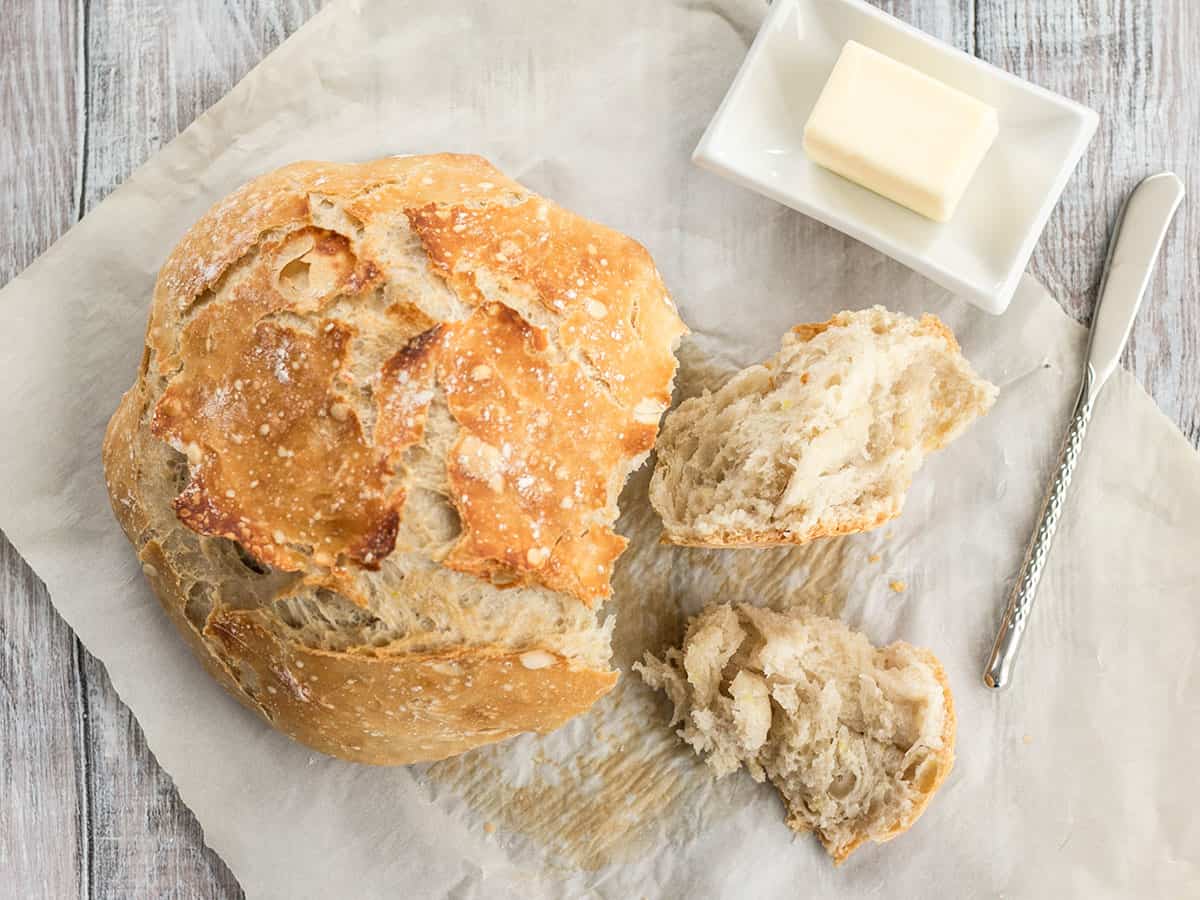
How to Make No-Knead Bread – Step by Step Photos
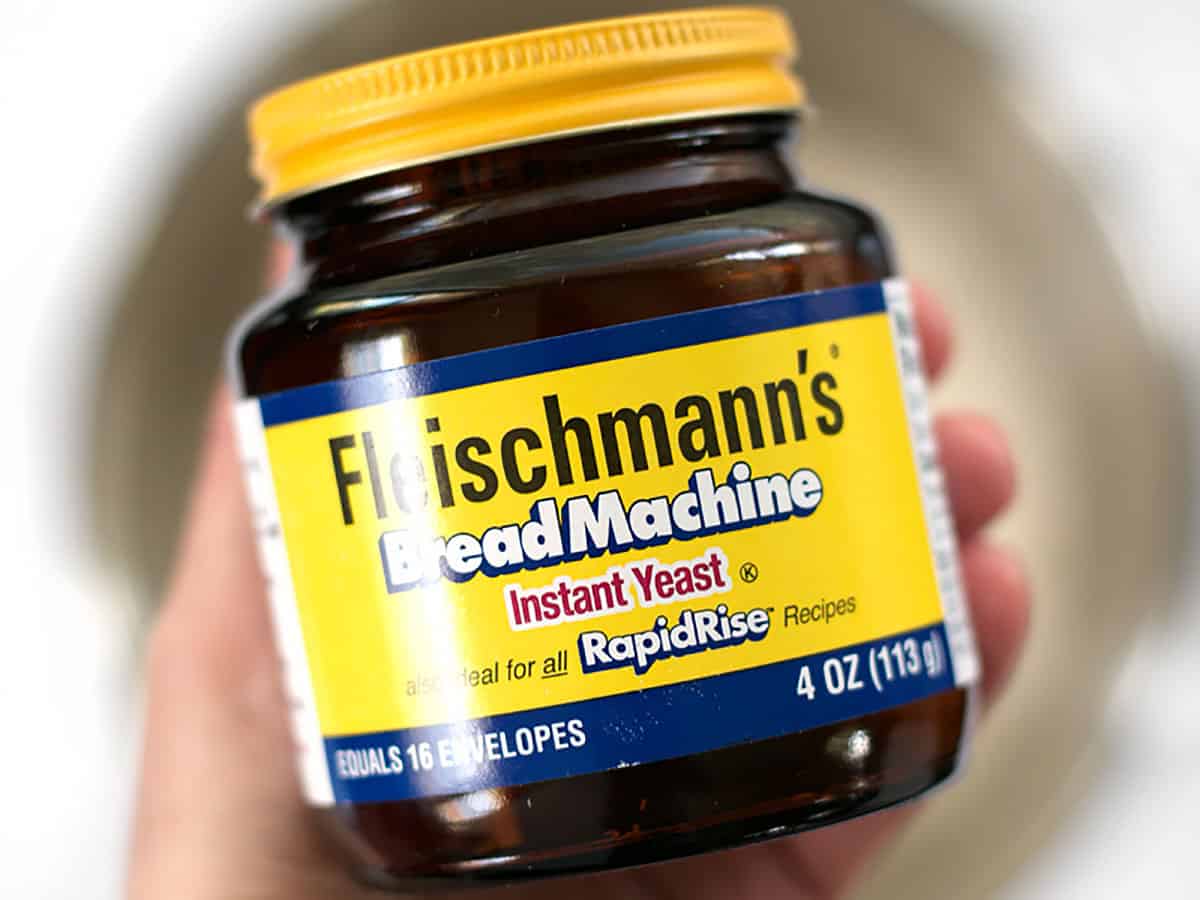
Before you begin, make sure you have “instant yeast” or “bread machine yeast” rather than “active dry”. The reason you need this type of yeast specifically is because it does not need to be kick-started by mixing with warm water first. You can add it to a recipe dry and it will still activate. I buy these little jars, which I keep in my fridge, and they last for-ev-er (especially when you’re only using 1/4 tsp at a time)!
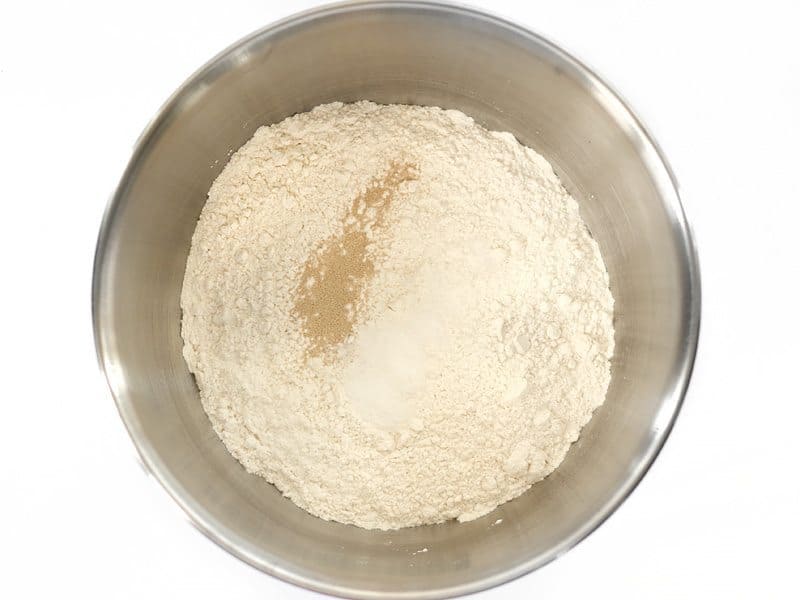
The day before you want to actually bake the bread, combine 3 cups all-purpose flour, 1/4 tsp instant or bread machine yeast, and 1/2 Tbsp salt in a large bowl. Stir them together really well.
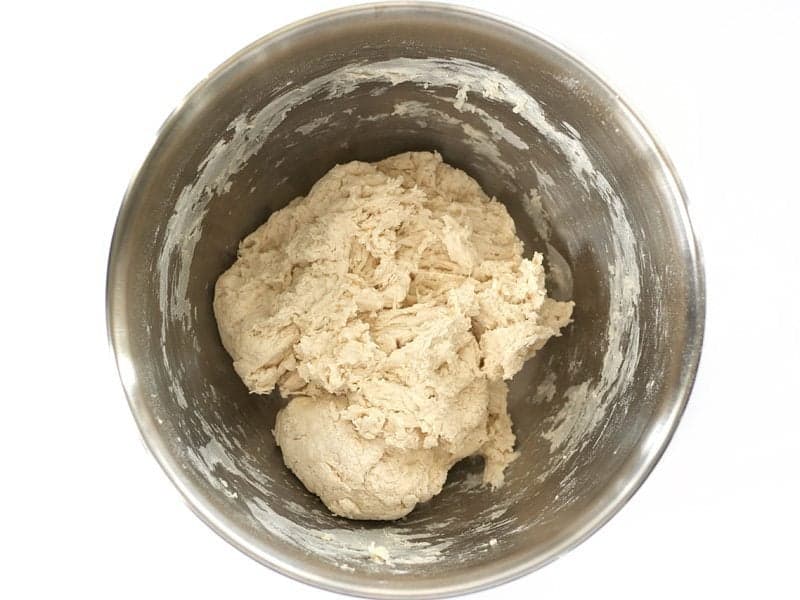
Stir in about 1.5 to 1.75 cups of room temperature water, or just enough to form a shaggy ball of slightly sticky dough, and no dry flour is left on the bottom of the bowl. The total amount of water needed may vary from time to time depending on the ambient humidity and moisture content of the flour, so go on visuals here. Make sure it comes together in one ball and no dry flour is left on the bottom of the bowl. It’s okay for it to be a bit sticky.
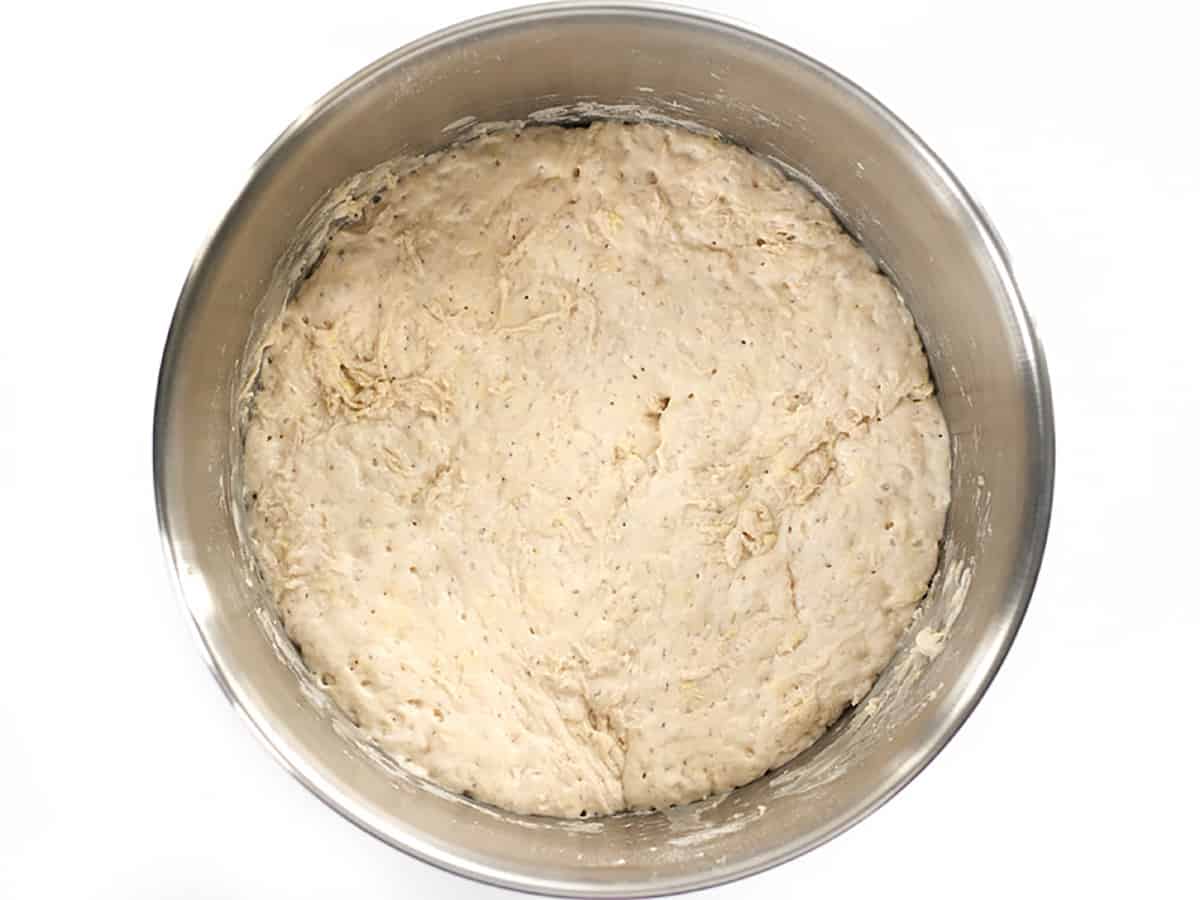
Loosely cover the bowl with plastic and let the dough ferment at room temperature for 12-18 hours. If you need to let it sit longer than that to fit your schedule, just transfer it to the refrigerator. As the dough ferments, it becomes very big, light, fluffy, and bubbly.
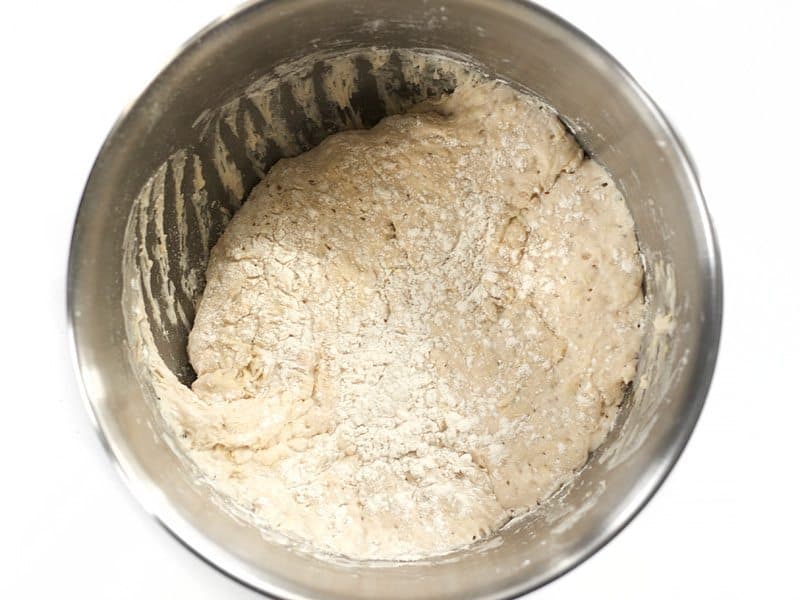
Sprinkle a little flour onto the dough (because it will be sticky) and scrape it out of the bowl. It will begin to deflate as you scrape it out.
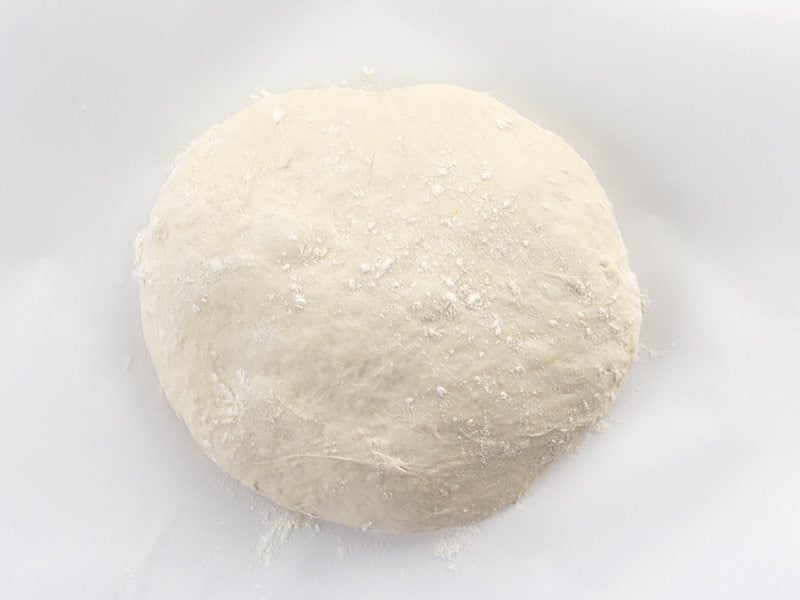
Using floured hands, shape the dough into a ball, then place it on a large piece of parchment. Let the dough rise for 30-60 minutes. The shorter rise time will produce a slightly more dense bread and the longer rise time will have larger bubbles.
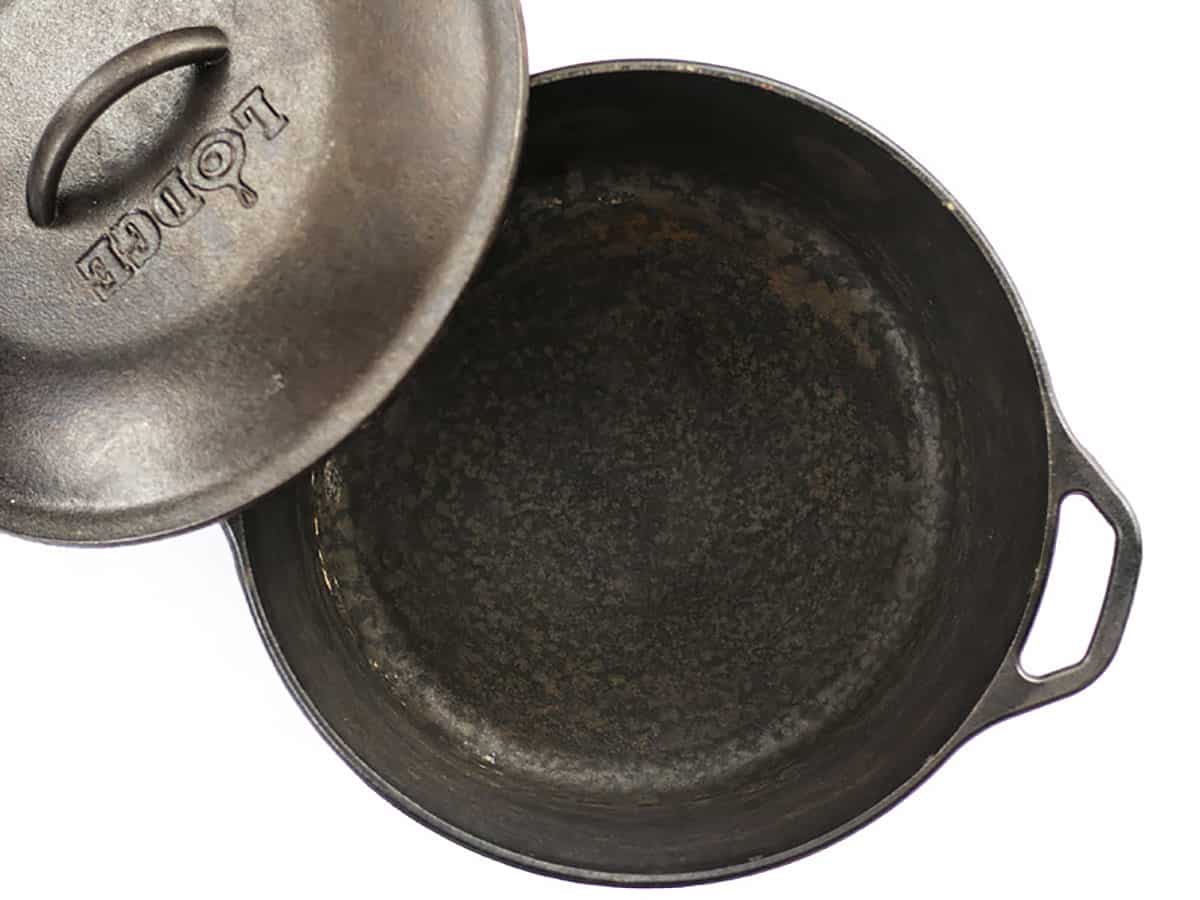
While the dough is rising, begin to preheat the oven and the Dutch oven. Set the oven to 425ºF, or whatever the highest safest temperature is for your brand of parchment (it will usually be listed on the box somewhere). Make sure your Dutch oven is inside the oven as it preheats, and then let it heat for an additional 15 minutes or so once the oven is up to temperature. This makes sure that the Dutch oven is nice and hot.
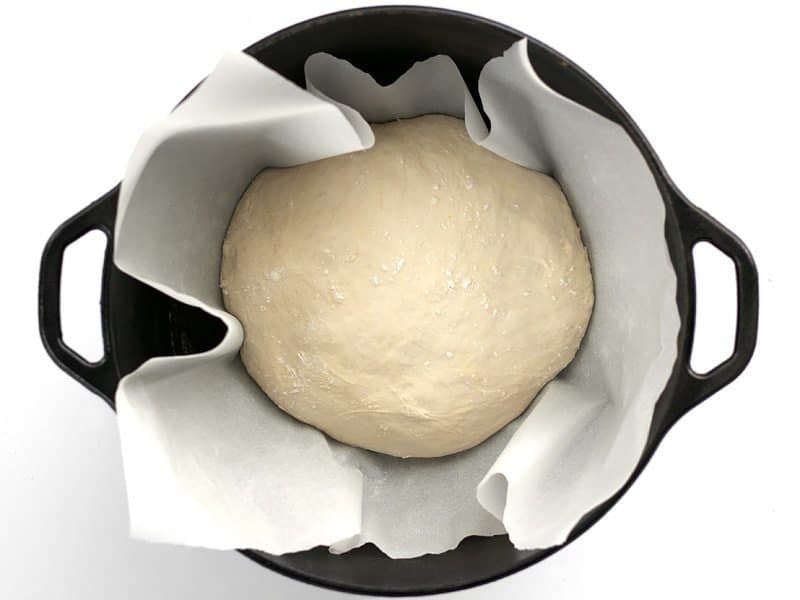
When the dough is risen and the Dutch oven is fully preheated, carefully remove the Dutch oven from the oven (it will be extremely hot!). Lift the risen dough by the parchment and place it inside the Dutch oven, parchment and all. Place the lid on the Dutch oven and return it to the hot oven.
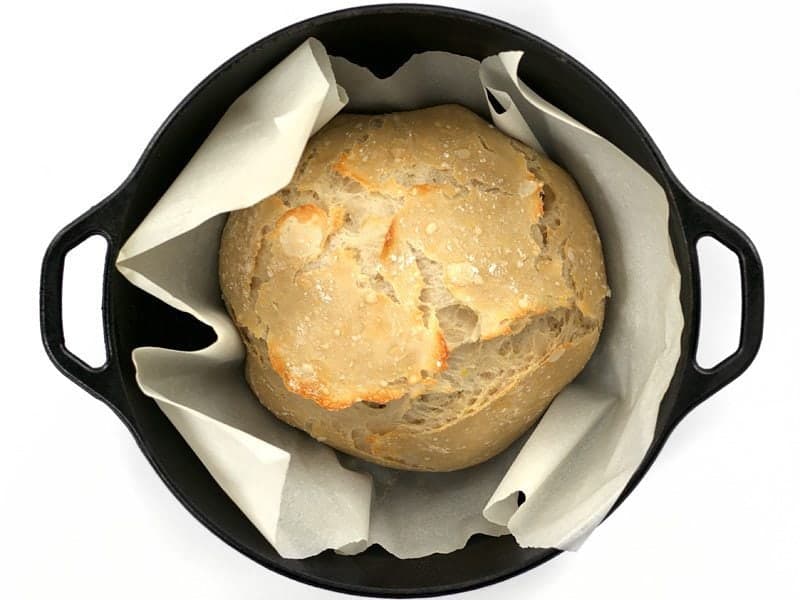
Let it bake for 30 minutes with the lid on the Dutch Oven, then carefully remove the lid…
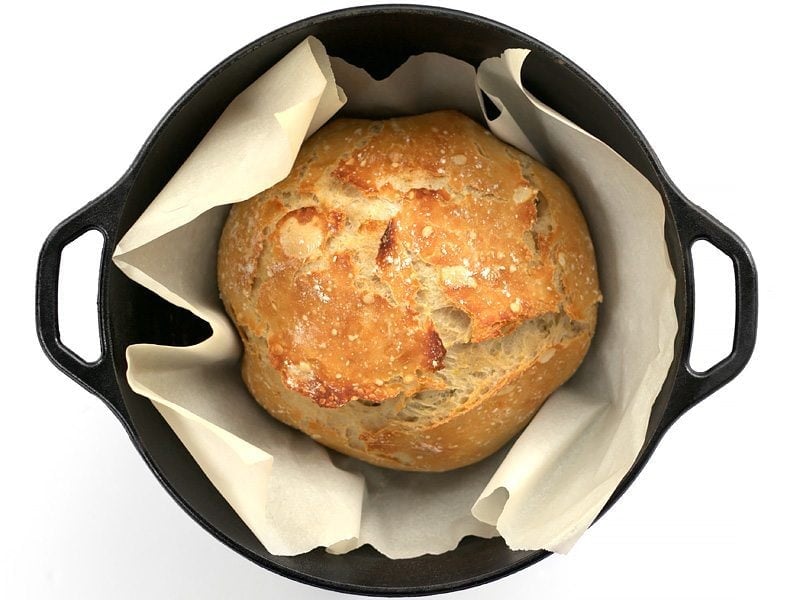
Then bake it for an additional 15 minutes or so WITHOUT the lid to allow the crust to brown.
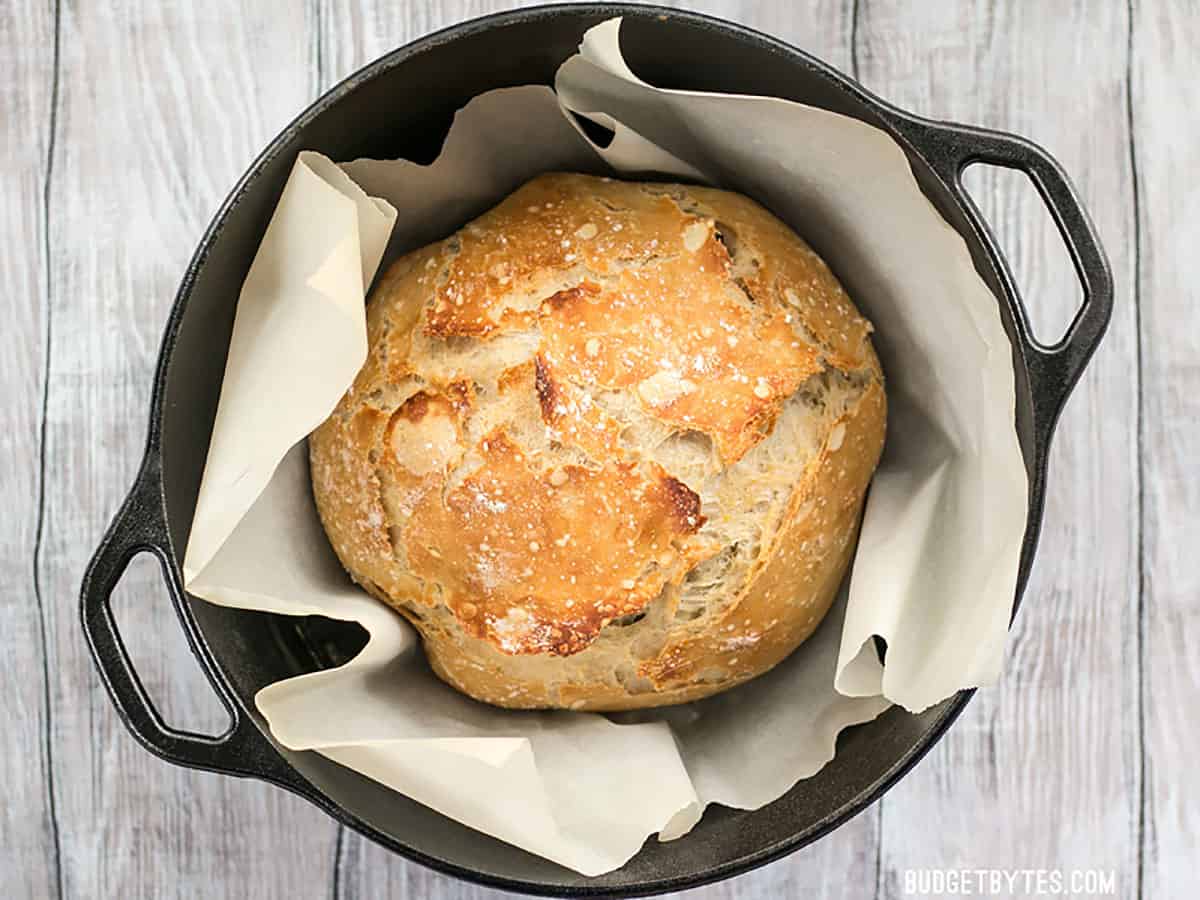
Once the crust achieves a nice deep golden brown color, carefully remove the Dutch Oven from the oven. Lift the no-knead bread out of the Dutch oven by the parchment, and allow it to cool before serving.
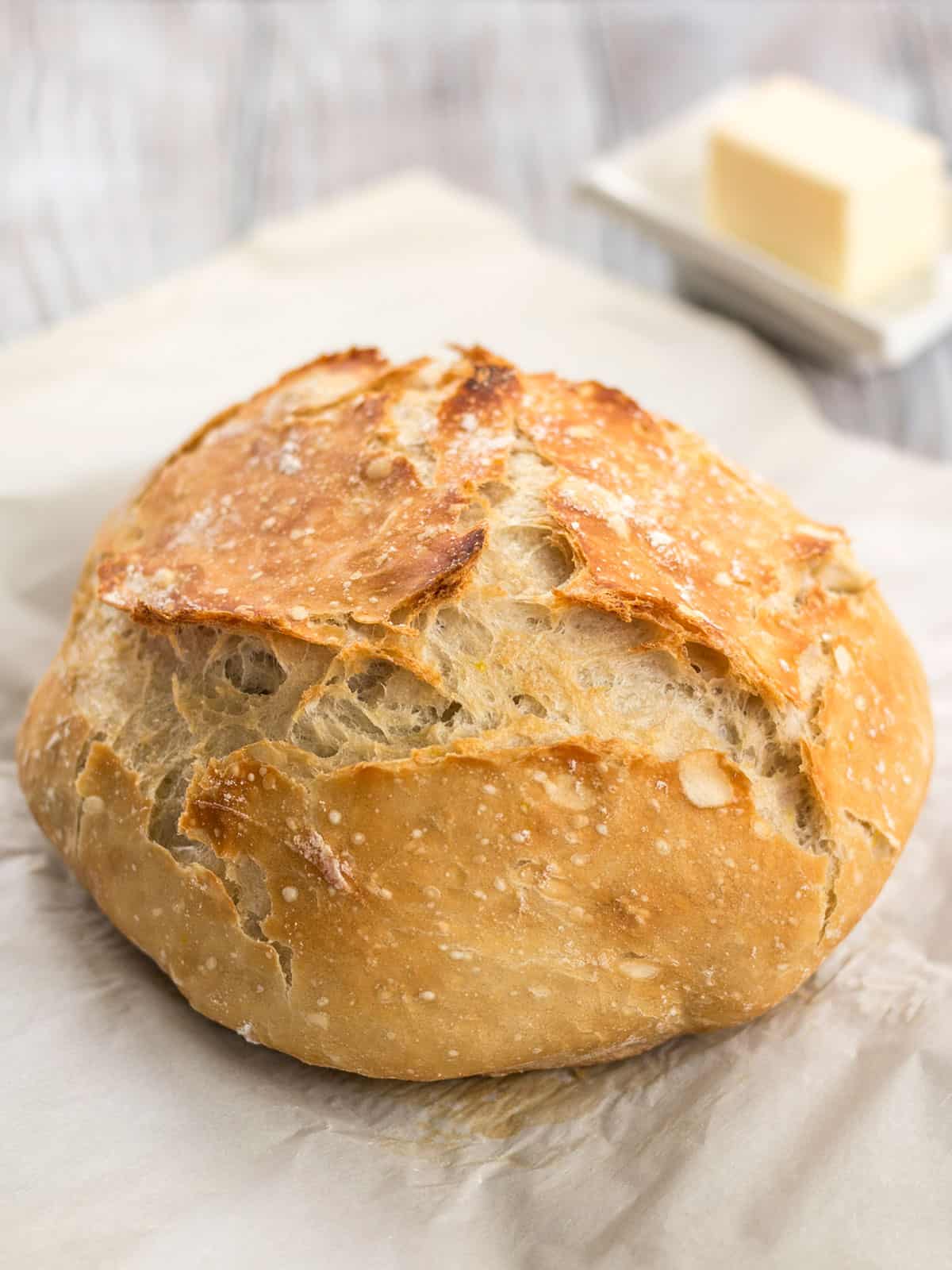
And just be prepared for the BEST bread you’ve ever made yourself. ;) The crust on this no-knead bread is seriously amazing.
No Dutch Oven and Short Fermentation Instructions
So, as I mentioned before, you can still bake this bread without a Dutch oven and with a short, 2-hour fermentation time. Here is a photo of my no-knead bread using just 2 hours of fermentation (plus another 1 hr rise time) and baked on a baking sheet.
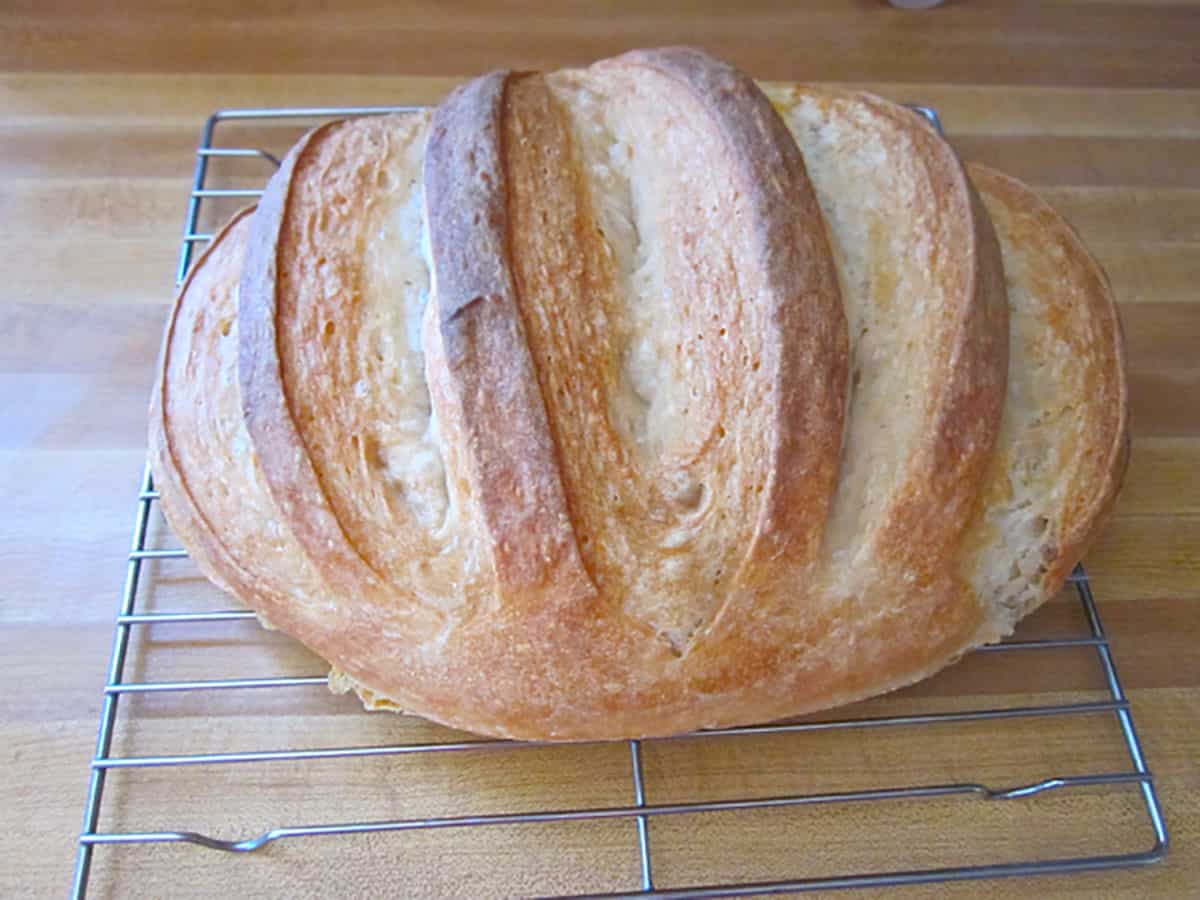
If you only have about 2-3 hours to ferment the dough, you’ll need to increase the amount of yeast used to 2 tsp (instead of 1/4 tsp).
Let the dough ferment in the bowl for 2 hours, then shape it into a loaf, transfer it to a baking sheet covered with parchment (and sprinkled with cornmeal, if desired) and let rise for about another hour. I like to make slits in the top with a sharp knife after the loaf has risen. Be careful though, if the knife is not sharp enough or you use too much downward pressure, it can deflate the dough.
Brush the surface of the dough with water, then bake it in a preheated oven (again, as hot as the parchment will allow, usually around 425ºF) for 30-40 minutes, or until the crust is nicely browned.


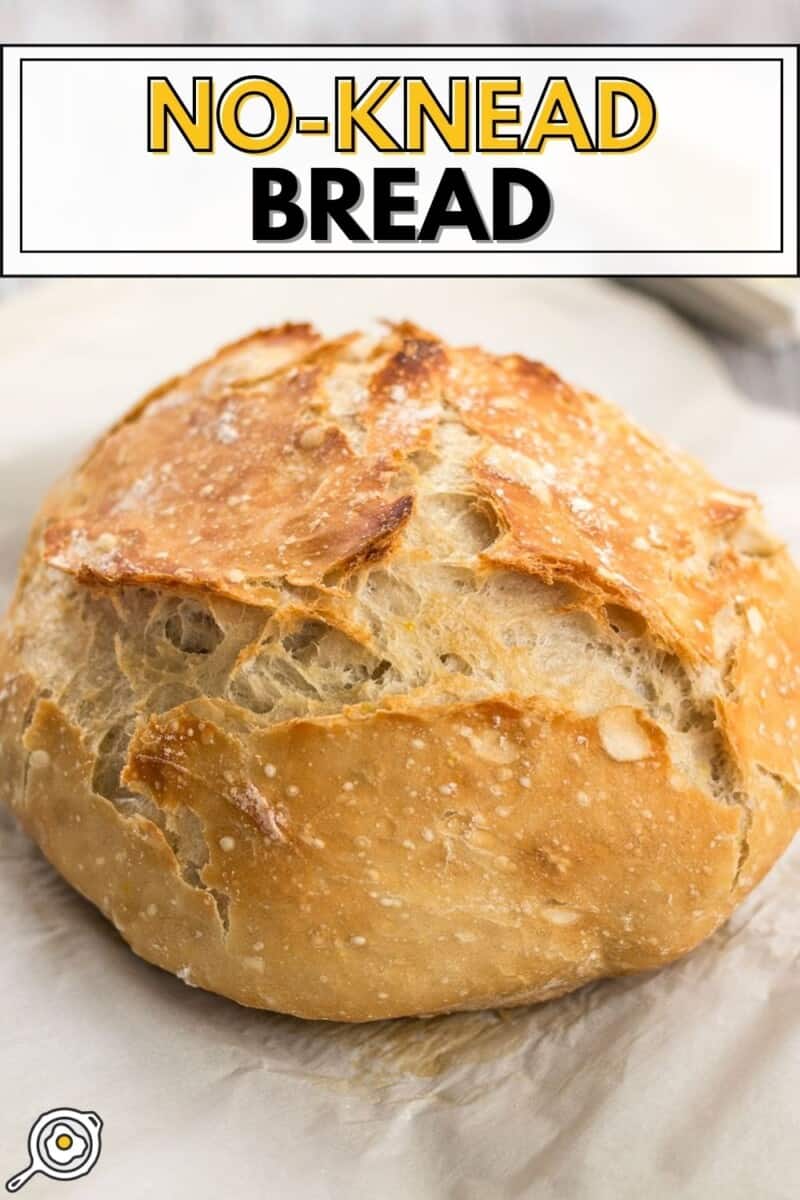
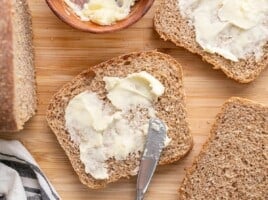
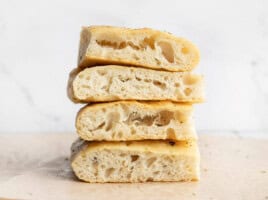
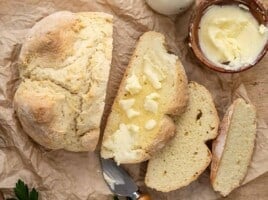
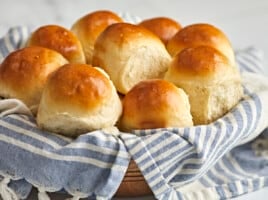
This bread is such a gem. My first EVER bread making attempt was this recipe and now I’ve made it over 30 times in about 6 months. This is the easiest beginner recipe there is.
The crust is perfect and the inside soft and moist. The ideal crunchy bread for soup dipping or a runny fried egg. I wouldn’t recommend this one as much for sandwiches as the crust is quite crunchy.
I slice it when fully cool and store in a gallon bag in the refrigerator for easy access and freshness for a week (never lasts that long though!)
This turned out great! Excited to try more breads now. I used a stainless steel dutch oven which I was nervous about but turned out fine. My parchment paper only goes up to 400 degrees, so I would recommend adding 5-10 minutes on both the covered and uncovered portions for the lower temperature. Thanks Beth!
This turned out great! So easy to make too. Do you have any recommendations for the best way to store it? Have you frozen this bread?
Yes, you can definitely freeze this. :) No matter how you store it, it’s important to let it cool completely before transferring it to any type of container, bag, refrigerator, or freezer because you need to make sure there is no more steam, which will form condensation. So, let it cool completely and then I like to put it in a gallon-sized zip top bag and keep in the refrigerator for a few days or in the freezer for a few months.
I’ve made this before and it turned out wonderfully! The perfect crusty bread to pair with soup. I was wondering about making a smaller loaf from a half-batch of the dough next time. I find that no-knead breads have a pretty short shelf life (2 days max?), after which they taste really yeasty. A smaller loaf would be eaten up more quickly, before it had time to go bad. So, anyway, if you were halving this recipe, how would you alter the baking times, if at all? Thanks :)
I do half loaves all the time! But the weird part is that I don’t remember exactly how long I bake them. Ooops. I would try 20 min with the lid on, then 10 with the lid off.
That turned out fine. Thanks! :)
I make this recipe a lot and it’s my go-to bread recipe!
I do have a few comments though. 1. If you want to only let it rise for a few hours, double the yeast ( 1/2 tsp instead of the 2 tsp listed). 2 tsp yeast is not necessary! 2. It holds well to all sorts of flavor additions- dried chopped rosemary, garlic powder, Italian seasoning, caraway seeds, (soaked) dried onion flakes, everything bagel seasoning (as a topper), etc. Go wild and make your own flavor combinations! I usually do 1-2 tbsp of additions (so, for herby garlic bread, I do 1 Tbsp each of garlic powder and Italian herb blend).
3. I have made this in a slow cooker as well as an oven, and it turns out nicely, though with a much softer outside (which is very nice for slicing into sandwiches). Usually, I put a trivet in the bottom of my slow cooker, pour in a few cups of water, then add the dough to a greased glass baking dish and put it over the water. I let it rise over the warm water for ~30 minutes, then turn on the slow cooker to high, cover, and let bake for an hour. You’ll want to put a kitchen towel or a few layers of paper towel between the slow cooker vessel and the lid, to catch excess moisture, though. When it’s done, remove from the baking dish and let cool completely on a cooling rack (to remove excess moisture).
I’m sorry if this has been addressed and I’ve missed it. But does anyone know how much whole wheat flour I can use in this and still get a similar Result?
Never mind. Found my answer when I saw the older comments . Sorry and thanks!
I suggest up to half of the total flour.
I made this into pizza crust and it was SO delicious! Thank you!
Should I use bread flour or just ordinary flour?
I used all-purpose flour.
Thanks Beth. I did it with all purpose flour and it rose really well overnight, however when I put it on the parchment for the 2nd rise it didn’t seem to do much. It’s in the oven now so fingers crossed for a fluffy loaf and not too dense. 🤞😊
Hi Beth
It was very dense almost like crumpet. Not sure what I did wrong.
Are you using instant yeast or active dry? It has to be instant yeast (sometimes called bread machine yeast) because active dry needs to be dissolved in water first, so it won’t work with this method.
Yes I’m using instant yeast. I rose really well on first prove. I posted a pic of my loaf on the front page.
Can I make this using wild yeast that I made? How much would I use? Thank you!
Unfortunately I’ve never used wild yeast, so I’m not sure how to convert the recipe to use it.
Any tips on how to make a rosemary version of this? I was just curious if the fermentation would cause the seasoning to increase in flavor, requiring that you use less seasoning than a kneads bread?
This was fun and so dang yummy! Will make again. It didn’t quite have the look at your crust, but I will try with less water this time.
Hi B eth, I have made this recipe at least 100 times. Always turns out perfect and delicious. So good that I have even stopped buying store bread. Currently have this, along with your focaccia bread, resting for tomorrow (bake). Thanks for the great recipes – every recipe I have made has been successful,
Thank you!
I have been making double batchs of this bread for years. My question is how large of a batch gan I do at one time? 3,4,5 times???
That’s a good question! I’m really not sure. I’ve only done regular and half-sized batches. I do know that some people leave the dough in the refrigerator for a week or so, though, and just take off pieces to bake every day.
Every time I try to make no-knead bread, I end up with a pile of massively sticky, unshapeable dough after the first rise! No amount of added flour seems to make it pliable enough to do anything except dump onto a baking sheet in a blob.
What’s the secret to shaping this kind of dough?
I would try using slightly less water to begin with, but a sticky mass of dough is definitely what you should end up with. I add just enough flour after the fermentation to be able to scrape it out of the bowl without it sticking to my hands, and just kind of fold it over itself a few times. It’s definitely a wobbly blob and you don’t really “shape” it. That high moisture content helps it puff up into a nice dome when it goes into that super hot oven.
You speak of fermentation. So does this mean this is a sour dough bread recipe? Sorry, I’m newer to baking bread.
I love your recipes so far. Love that you have the function to increase serving sizes on some of your recipes. Saves calculation headaches. Going to try your rosemary beef stew this week. Want to make this bread but my kids don’t like sour dough. So that is the reason I ask. Thank you so much!
Nope, it doesn’t ferment long enough to actually become a sour dough, so you won’t have any of that tangy flavor. :) Sour dough requires a longer fermentation.